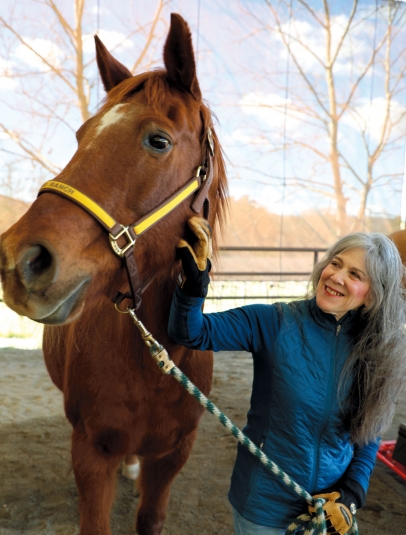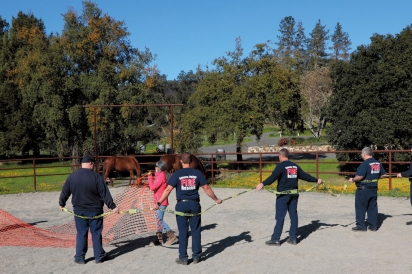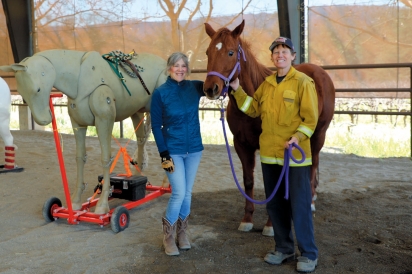Julie Atwood's Halter Project
PROVIDING READINESS TRAINING TO RESIDENTS AND FIRST RESPONDERS
Most people don’t like to prepare for an emergency. Even with the best of intentions, the majority of us still put off taking action. As we were reminded during the North Bay wildfires in the fall of 2017, however, when seconds count, having a plan can mean the difference between life and death—for humans and animals alike.
Suburban and rural areas like those that make up a significant portion of Marin, Napa and Sonoma counties are often the hardest hit in disasters. So what are we waiting for?
Enter Julie Atwood, founder of the HALTER (Horse and Livestock Team Emergency Response) Project. Atwood has made it her mission to help our community ready itself for these kinds of disasters, including facilitating training for first responders to enable them to approach animal-related emergencies in a safe and humane manner. She also promotes personal preparedness education and provides resources to rural communities that might otherwise fall through the cracks in government-run programs.
“Many smaller farmers and producers do not utilize resources such as the UCCE [University of California Cooperative Extension], and are not members of organizations like the Farmers Guild or the Farm Bureau,” says Atwood. “HALTER can provide outreach and support that helps bridge that gap.”
The self-funded program uses a three-pronged approach, serving as an informational resource, offering specialized training, and hosting community outreach programs. In most instances, the HALTER Project provides support to fire departments and animal welfare agencies by making grants for the purchase of equipment, and offering scholarships to those interested in becoming state-certified Animal Technical Rescue (ATR) technicians and instructors.
Safety for the rescuers, the animals and bystanders is the primary focus of HALTER trainings, as is proper technique for successfully approaching and handling animals in stress situations. Trainings cover animal behavior, anatomy and herd movement, as well as challenges presented by livestock guardian dogs and other “working dogs.” To date, around 200 Northern California first responders have participated in HALTER-sponsored trainings.
In the five years since its inception HALTER has garnered national distinction, receiving the Federal Emergency Management Agency’s Awareness to Action Award in 2016, for outstanding service to underserved communities.
“We believe the best outcome for animals and people happens when trained first responders, veterinarians and animal owners are working safely together,” says Atwood, who is quick to point out that the HALTER Project itself is not an emergency response team.
A lot of skill, technique and special equipment are needed to get an animal out of a stuck place. And learning on the job is definitely not the best plan. HALTER trainees practice with life-size, fully articulated, 900-pound rubber equine mannequins in simulated scenarios, while strategizing best practices to use during a rescue. Recently acquired canine mannequins add another dimension to the realism of training.
HALTER also brings in live animals during training, which helps to build confidence in first responders who often interact with horses and other livestock during everyday duty in rural communities. In the North Bay, calls for help run the gamut from common occurrences such as livestock stuck in mud or trapped in abandoned wells and septic tanks, to transportation and trail-riding accidents involving people and animals. Loose and injured livestock on rural roads and highways is another dangerous hazard that requires quick action by first responders.
Unexpected emergencies also arise on rural ranches and farms. It was, in fact, a personal experience on a cold, rainy December night in 2013 that inspired Atwood to establish the HALTER Project. One of her older horses had slipped and rolled down a muddy slope in the storm. Unable to right itself, the exhausted animal was in trouble— and she was alone.
“All I could do was wait for help,” recalls Atwood, as she tried to stabilize her old buddy. It was two hours before the veterinarian arrived, and during that wait she vowed to develop a neighborhood resource that became the foundation for HALTER.
“Sometimes a simple maneuver is all it takes,” she says, “but knowing what to do is key when you’re dealing with a tired, frightened animal.”
In addition to rescue, Atwood stresses biosecurity education as a top priority in HALTER trainings. Take for example the story of the “Silkie Chicken.” In a frenzy during the catastrophic Lake County Valley Fire of 2015, Silkie’s owner posted a photo of her chicken on social media, along with a plea for someone to save the hen. The post went viral and Silkie became an instant social media phenomenon. Good Samaritans, acting independently, came to the rescue, finding the chicken and taking it to Petaluma. What seemed like an act of heroism, however, could have had devastating economic consequences.
“At the time there was an active outbreak of Avian flu [in Lake County],” says Atwood. “If that one chicken had been infected, it could have shut down the entire commercial poultry industry in two counties—or worse. Those well-intentioned but unauthorized volunteers didn’t think about that.”
This cautionary tale perfectly illustrates what is known as “second wave disaster,” when well-meaning civilians spontaneously self-deploy in an emergency. “With no coordinated effort, or communication with emergency managers, these unregistered volunteers rush in at great risk to themselves and others, including the first responders who may have to rescue them,” says Atwood.
The value of HALTER initiatives was reinforced last fall when catastrophic wildfires swept through parts of Sonoma, Napa, Marin, Mendocino and Lake Counties.
Atwood’s own ranch sprawls at the base of the Mayacamas Mountains on an 80-acre corner between Highway 12 and Nuns Canyon Road. Atwood recalls feeling “seriously scared” about the weather conditions leading up to the firestorm that night. It had been a hot, windy day, and red flag alerts had been issued. It was around 9:50pm on Sunday, October 8, when she first smelled smoke. Opening the back door to investigate, she was nearly knocked off her feet by a blast of hot air. The nearby hills were already ablaze.
“The fire was on us before anyone even knew it had started,” she remembers soberly. “There was no time to get out. Trying to move the animals off our property would have been dangerous, if not impossible”.
Fueled by hurricane-force winds, the flames reached their driveway in seconds. Embers and burning debris were flying all directions.
With their lives and the lives of their six horses, a mule and several cats at stake, the response needed to be swift and sure. “Animals, especially horses, depend on their humans for leadership in a stress situation,” she says. “They were ready and waiting for us to lead them to safety.”
In just seven minutes, she, her husband and a ranch hand enacted their emergency plan to shelter in place. Calmly and quickly, they moved all the animals to an open arena on another part of the property. It was a designated safe space surrounded by vineyard and roads where they had cached emergency tools, supplies and water.
There, they hunkered down and fought the fire for the duration, figuring they would never see their home again.
In the tense, uncertain days that followed, the Atwoods brought all that they knew about surviving in an emergency to task. With no operational land lines or internet, they had to rely on texting to communicate with emergency personnel and frantic neighbors unable to return home. Atwood was inundated with messages from people needing help and rescue information.
As a registered Animal Disaster Service Worker, she became a point of contact for Sonoma County Animal Services, and was one of a handful of civilians authorized to assist. More than a dozen roadblocks surrounding their ranch prevented non-authorized access, and no one who left was allowed back in. Residents were frantic to reach animals left behind as they fled the flames, and conflicting reports added to the hysteria. Slowly, Atwood was able to visit neighborhood properties to assess and care for animals sheltered in place.
Four days later, Atwood’s animals were evacuated to a ranch in Red Bluff. Miraculously, the Atwood’s home had survived, but the livestock shelters were destroyed, along with the metal fencing.
Even amid the horror and its aftermath, there were inspiring moments that stand out for Atwood. Eight days after the fire started, she and her husband made their way to the local fire station in Glen Ellen for their first shower and hot meal in over a week.
As they looked on, a team fresh off the fire line rolled in, and a female firefighter covered in ash and soot jumped off the engine. Atwood recognized the young woman as an ATR student.
“Julie!” she hollered over the noisy engines. Exhausted but grinning, words poured out: “I got to use my technical animal rescue training! Everyone was afraid, but I saved all the horses and goats!”
The woman went on to share how she and her engineer teammate had safely evacuated the livestock, as well as the frightened property owners, who were unwilling to abandon their beloved animals, thanks to what they learned in trainings. The women hugged and they both cried, bonded by the knowledge that each had made a difference when it mattered most.
“Moments like this are threads that weave us together in this important work,” says Atwood. “It’s why I get up in the morning.”






